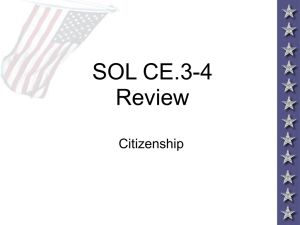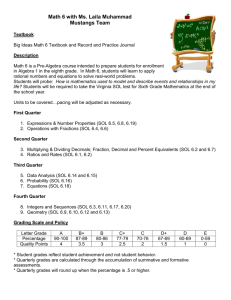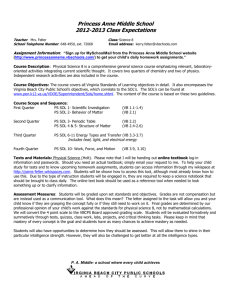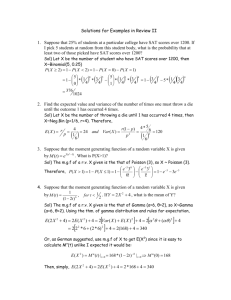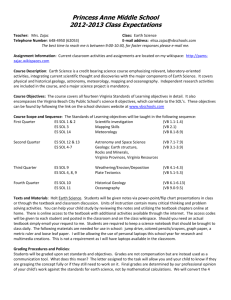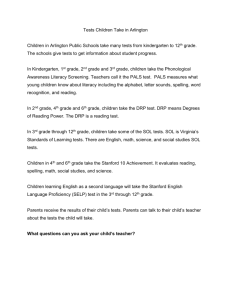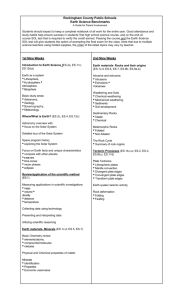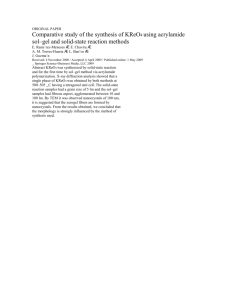VASS White Paper on Assessment and Accountability in VA
advertisement
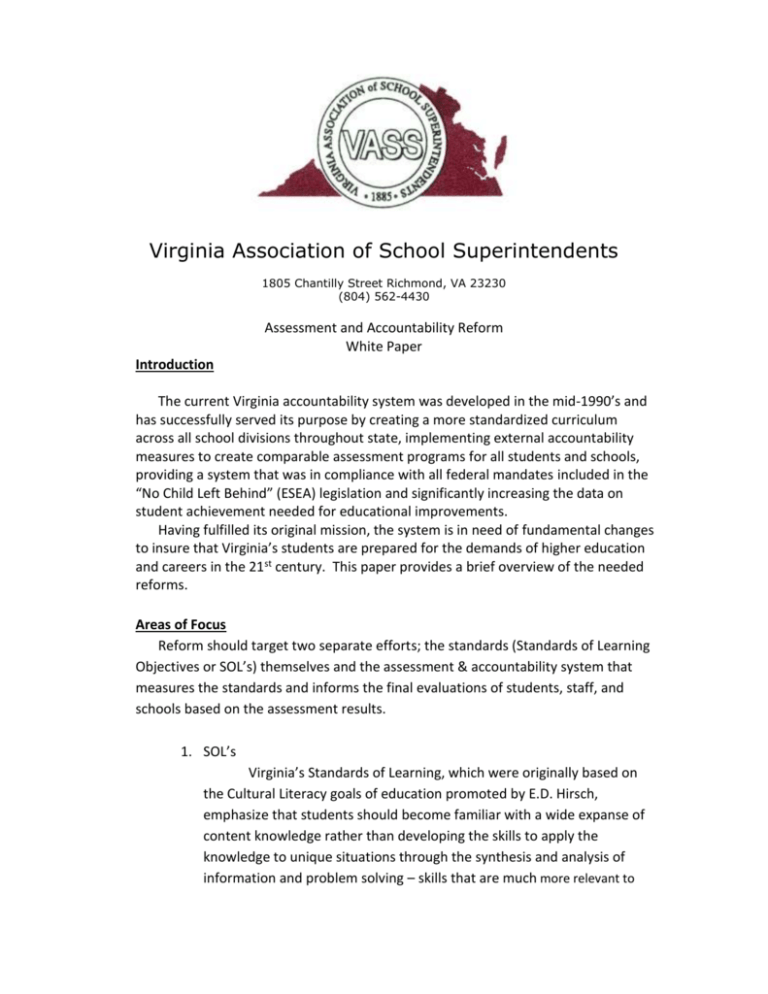
Virginia Association of School Superintendents 1805 Chantilly Street Richmond, VA 23230 (804) 562-4430 Assessment and Accountability Reform White Paper Introduction The current Virginia accountability system was developed in the mid-1990’s and has successfully served its purpose by creating a more standardized curriculum across all school divisions throughout state, implementing external accountability measures to create comparable assessment programs for all students and schools, providing a system that was in compliance with all federal mandates included in the “No Child Left Behind” (ESEA) legislation and significantly increasing the data on student achievement needed for educational improvements. Having fulfilled its original mission, the system is in need of fundamental changes to insure that Virginia’s students are prepared for the demands of higher education and careers in the 21st century. This paper provides a brief overview of the needed reforms. Areas of Focus Reform should target two separate efforts; the standards (Standards of Learning Objectives or SOL’s) themselves and the assessment & accountability system that measures the standards and informs the final evaluations of students, staff, and schools based on the assessment results. 1. SOL’s Virginia’s Standards of Learning, which were originally based on the Cultural Literacy goals of education promoted by E.D. Hirsch, emphasize that students should become familiar with a wide expanse of content knowledge rather than developing the skills to apply the knowledge to unique situations through the synthesis and analysis of information and problem solving – skills that are much more relevant to the demands of the 21st Century global economy. There are simply too many mandated standards currently in place. The sheer number of standards and their knowledge-based requirements force teachers to focus on rapid coverage of content at the expense of a depth of student understanding. GOAL: To reform the Standards of Learning to facilitate depth of understanding vs coverage of content. Recommendation: Allow the existing reform schedule cycle for SOL review to eventually reduce the total number of standards and create standards that encourage depth and understanding (fewer #, more “depth”). Rationale: Global competitors are known for a focus on depth and not breadth; the application of knowledge and not just the acquisition of knowledge. As Virginia students are compared in international studies, a renewed focus on deeper learning will likely yield improved results. Target Completion: 2018 2. Assessment and Accountability System The current system requires too many state-directed tests (minimum of 34* from grades 3-11) and is too reliant on a single source assessment (SOL tests). As a result, classrooms are focused on preparing students for tests. An unintended result of this over-reliance is that SOL Test results are being used for purposes not intended (we have one tool for many missions) * Appendix 1 provides a summary of the mandated SOL Tests GOAL: To create a new assessment and accountability system that supports 21st century learning needs and workforce development. Short Term Recommendations (2014 General Assembly session) o Reduce the number of required SOL Exams to better align with the federal requirements of the “No Child Left Behind” legislation. Eliminate Social Studies SOL exams in Grades 3-8 Test science only at Grades 5 and 8. Maintain current End of Course high school exams for the short term Maintain current writing exams o o o o o o o Total of 20 SOL Exams (from 34 currently) Rationale: Aligning the number of SOL Exams with federal mandates secures compliance and eligibility for federal funding while maintaining accountability and reducing the over-emphasis on testing. It also permits school divisions to pilot alternate assessments that may be used in the long-term reform of the accountability system. Approve expedited re-takes for all students “close” to passing Rationale: Currently, only high school students with “near passing” scores have access to re-takes on SOL Exams. Elementary and middle school students do not have the same access. The margin of error inherent in the development & scoring of SOL tests** as well as the process to adjust from raw scores to scaled scores threatens the accuracy of failed scores near passing rates. All students should have access to expedited re-takes to insure that results are an accurate reflection of their proficiency and not the result of the margin of error inherent in the tests. ** Appendix 2 provides a brief description of the SOL tests and scoring Authorize pilot use of alternate assessments as “R & D” for potential use. Rationale: The state accountability system should include a broad array of assessments to fairly and accurately ascertain student achievement based on the variety of ways that students learn and demonstrate their acquisition of knowledge and skills. Encouraging research & development of potential assessments will facilitate the state’s work to create multiple assessment types. Delay A-F Report Card implementation to permit the overall development and improvement of the accountability system of which the Report Card may be one piece. Rationale: The State Superintendent of Public Instruction as well as the State Board of Education have stated the end for additional time to explore criteria in support of Grading schools A-F. Delaying the implementation of this system will encourage a more authentic set of criteria and increase school and community use of the grades to improve instructional practice. Mid Term Recommendations (within 2 years) o Establish a Task Force Report to complete reform of the state assessment & accountability system o Task Force Membership: Secretary of Education/staff Educators (teachers, principals, superintendents, school board members) Parents Legislators and Governor’s administrative staff Higher education representatives Business representatives o Considerations of the Task Force: Develop or recognize additional assessments (beyond SOL tests) Examples include some tests already given in many schools such as Advanced Placement Exams or International Baccalaureate Exams Workforce skills assessments Workforce credentialing assessments Locally developed assessments Authentic student growth measures The NAEP assessment PSAT tests International benchmark assessments such as the Cambridge Assessment and PISA Group schools by “like” demographics” (SES, ELL, mobility, cost per pupil) for comparison to facilitate identification of true “best practices” in matching circumstances Use Student sampling for portions of mandated checkpoints Broaden the A-F Grading system beyond a single grade for the entire school Assign multiple grades (not one) Measure all content (not just SOL tested areas) Include data not currently collected such as o Extra-curricular offerings o Parent satisfaction o Faculty licensure & qualifications o External awards or recognitions earned (such as Blue Ribbon schools) o School Safety data o o Target Completion: 2016 Long-Term Recommendations o Implement the Reformed accountability/assessment system o Implement the expanded A-F Grading system o Complete revision of all SOL’s APPENDIX 1 Summary List of State mandated SOL Exams Accreditation Rating System Schools not meeting one of the pass rates listed below will NOT be considered FULLY ACCREDITED Grade Grade Grade Grade Grade Grade End of Course 3 4 5 6 7 8 EOC Subject English 75 75 75 75 75 75 75 Math 70 70 70 70 70 70 70 History 70 70 70 70 70 70 Science 70 70 70 70 Graduation and Completion Index 85 pts. EOC (End of Course) SOL Exams are mandated for courses as follows: English: Reading/Writing Math: Algebra I, Geometry, Algebra II Science: Earth Science, Biology, Chemistry Social St: Va. And U.S. History, World History I, World History II, World Geography EOC Exams are taken the year students are provided the course content (EX Algebra I could be taken in middle school) APPENDIX 2 DSCRIPTION OF SOL EXAMS AND SCORING When are the SOLs given? What do the SOL tests look like and how are they scored? • The SOLs are made up of 35-50 test questions that measure content knowledge, scientific and mathematical Most SOL tests are processes, reasoning and critical thinking skills. given in the late • English writing skills are measured with a two-part Spring of each year. assessment that includes multiple-choice and a short The writing test is response essay. given in March to What do the scores mean? grades 5, 8 and 11. It’s given earlier • Student performance is graded on a scale of 0-600 with because it takes 400 representing the minimum level of acceptable longer to score them. proficiency and 500 representing advanced proficiency • The Board of Education has defined three levels of student achievement: • Basic • Proficient • Advanced


